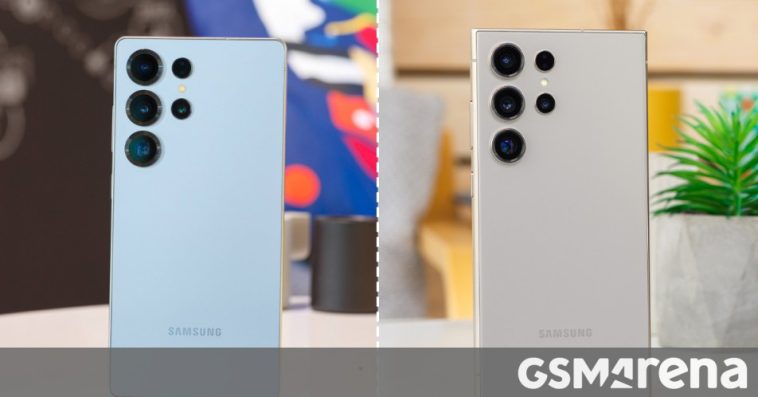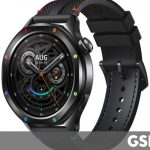The Galaxy S25 Ultra is out, bringing the usual set of small upgrades over the previous model. Alongside the mandatory chipset refresh and subtle design tweaks, we’re getting a new camera (just one, and more of a sidestep than an obvious upgrade), plus what’s looking like a downgrade to the S Pen. In the next few paragraphs, we’ll be examining if the upgrades are worth it, or if the S24 Ultra is the better Galaxy Ultra to have – or at least the better value.
Table of Contents:
Design
Display
Battery Life
Charging
Speaker Test
Performance
Cameras
Verdict
For starters, you can compare the complete specs sheets or directly continue with our editor’s assessment in the following text.
Size comparison
You wouldn’t mistake the S25 Ultra for a compact phone by any stretch of the imagination and it’s every bit as Galaxy Note-like as you’d expect from the lineup – as is the S24 Ultra, of course. That said, on the new model, Samsung has managed to shave off 1.4mm from the width and 0.4mm from the thickness – it might sound negligible, but it’s actually quite the feat.
The numbers are half the story, but there are also some principle changes too. The overall flattening of everything – the display, the rear panel, but also now especially the sides – makes the S25 Ultra somehow more manageable in hand, more comfortable and safer to operate. That’s the general consensus in the office, at least – perhaps it’s worth trying both out in person to get a sense of which handset you prefer, because they do handle a little differently.
When it comes to materials and build, both handsets are an ensemble of Gorilla Armor and titanium. The S24 Ultra uses the first version of Corning’s glass-ceramic formulation under this name, while S25 Ultra has the second-gen product. The new model also replaces the grade 2 titanium with grade 5. Ultimately, the S25 Ultra should be more durable than the S24 Ultra, but how much of a difference that’s going to make in the real world is anyone’s guess. Both models have IP68 ratings, for what that’s worth.
Just like in previous years, there are two types of colorways you can get the S25 Ultra in – there’s one set that carriers and retailers get, and another, additional set that’s exclusive to Samsung.com. ‘Titanium’ is always part of the name, and Black and Gray are shared between the two generations, the other options differing slightly from year to year.
Perhaps here we should mention one of the disappointments of the year – the S Pen’s lack of power and connectivity. Sure, it still has the fine pressure sensing and remains an unrivaled proposition for scribbling things, drawing, and whatnot. But the stylus on the S25 Ultra can’t be used for air gestures (which doesn’t sound like too big of a deal) or for remote camera actuation (which is what is really going to be missed). So, in that sense, the S24 Ultra is the more feature-rich option.
Display comparison
Among the S25 Ultra’s few changes compared to the previous model is the display – its diagonal now stands at 6.9 inches as opposed to the 6.8 inches on the S24 Ultra and it’s a negligible difference in size.
Both panels have a 1,440×3,120px resolution in a 19.5:9 aspect ratio, and a 120Hz maximum refresh rate. There’s no Dolby Vision video support on either (just the Samsung-backed competing HDR10+ standard) and Samsung only promises 16M colors on both (8-bit panels; other makers offer 10-bit or even 12-bit color). These are pretty good screens and there’s not a lot of significant apparent differences – somehow it’s other brands that have superior specced displays.
In our brightness testing, we got more or less the same results from both Ultras – over 1,400nits in adaptive brightness mode and in the 750-800nits ballpark when setting brightness manually (with Extra brightness enabled; otherwise – in the mid-400s).
Of course, both displays feature Gorilla Armor protection and while the newer model has gen 2 of Corning’s super-special concoction (gen 1 on the S24 Ultra), both have anti-reflective properties that set them apart from the rest of the crowd. Again though – largely the same viewing experience on these two.
Battery life
The S25 Ultra doesn’t use the new silicon carbon type of battery and it comes with the same 5,000mAh capacity as the previous generation, so there doesn’t appear to be any upgrades in the battery hardware.
When it comes to converting those 5,000mAh into active use time, the new model showed modest improvements in our gaming test (11%) and in video playback (14%), and just barely inched ahead in voice calls and web browsing. Overall, we’d say the S25 Ultra’s advantage is as large as to be immaterial.
Charging speed
Both phones are rated for 45W charging. Neither is that a particularly high value, nor do Samsungs have a history of making the best of it, and indeed both models post unremarkable numbers for charging speed. The S25 Ultra does have a minor advantage in this race, but we don’t think that it’s significant enough to be a deciding factor.
Perhaps slightly more important is the S25 Ultra’s Qi 2.1 wireless charging support, which allows you to have cases with magnets for coil alignment, and potentially automatic coil alignment with some in-car wireless chargers – pretty niche, at this point.
Speaker test
The two phones have identical speaker configurations in principle – one driver on the bottom, and another one up top that also serves as an earpiece. They recorded the exact same numerical result for loudness in our testing, and while numbers don’t lie, the S25 Ultra did offer us fuller, nicer-sounding output in some of our test tracks. Another minor advantage to add to the list of minor advantages.
Performance
The Galaxy S25 Ultra is powered by the latest top-tier Qualcomm chipset, the Snapdragon 8 Elite. Similarly, last year’s model had the Snapdragon 8 Gen 3, the most powerful one at the time.
Both chipsets are in a “for Galaxy” spec, meaning marginally higher frequencies on this or that core compared to regular versions of the SoC found in other brands’ phones – no big deal in practice, and largely irrelevant when looking at two generations of Galaxies in isolation.
There’s an elusive 16GB/1TB memory version of the S25 Ultra in China, but other than that, both models come with 12GB of RAM and 256GB, 512GB or 1TB of storage – not much to set them apart there.
Benchmark performance
The S25 Ultra does score meaningfully higher in all benchmarks and is also significantly more powerful at AI tasks, so if ultimate performance is what you’re after, the answer is clear. That said, the S24 Ultra is no slouch itself and will remain relevant for a good few years. The 7 years of software support on both models more or less put them on a level playing field in terms of futureproofing.
Camera comparison
There’s little difference between the camera hardware that these two have – the only new bit, out of a total of five cameras, is the ultrawide camera. The S25 Ultra swaps out the 12MP unit for a 50MP sensor, in virtually the same size.
Speaking of, the 200MP main camera on the S25 Ultra is indeed the same as on the S24 Ultra and, well, the same as on the S23 Ultra before it. The telephotos have been carried over too.
Over on the front, there are no changes either – the selfie camera is the same as before.
Image quality
The hardware may be the same, but the processing has some minor tweaks and main camera shots on the new model exhibit less sharpening and a somewhat more natural detail rendition. That’s about as small a difference as one could spot though, and we’re not seeing any others.
Galaxy S25 Ultra daylight photo samples, 1x
Galaxy S24 Ultra daylight photo samples, 1x
At 2x zoom, even that minor difference tends to disappear.
Galaxy S25 Ultra daylight photo samples, 2x
Galaxy S24 Ultra daylight photo samples, 2x
The shorter teles on both phones capture essentially the same images.
Galaxy S25 Ultra daylight photo samples, 3x
Galaxy S24 Ultra daylight photo samples, 3x
Looking at images from the 5x zoom cameras side by side, you’d be scratching your head trying to figure out if they are, indeed, shot on two different phones.
Galaxy S25 Ultra daylight photo samples, 5x
Galaxy S24 Ultra daylight photo samples, 5x
At 10x zoom, the S25 Ultra does appear to be preserving a little bit finer detail – it’s still looking quite artificial, but there is better definition in its shots when compared to the S24 Ultra’s.
Galaxy S25 Ultra daylight photo samples, 10x
Galaxy S24 Ultra daylight photo samples, 10x
Interestingly enough, the S24 Ultra’s results from its ‘old’ ultrawide camera are that little bit sharper than the S25 Ultra’s ‘new’ one. Not a huge difference, of course, but even so – what kind of an upgrade is that?
Galaxy S25 Ultra daylight photo samples, 0.5x
Galaxy S24 Ultra daylight photo samples, 0.5x
There are some nuances between the results from the selfie cameras on the two phones, but generally, things are looking great on both. This isn’t going to be a deciding factor either, we reckon.
Selfie samples: Galaxy S25 Ultra • Galaxy S24 Ultra
In the dark, there’s a bit more of a generational divide on the main camera. Neither phone’s results are leaving us ecstatic, but somehow the S24 Ultra’s noisier, yet sharper shots are more to our liking. The S25 Ultra’s photos have a more smoothened appearance and not necessarily in a good way.
Galaxy S25 Ultra low-light photo samples, 1x
Galaxy S24 Ultra low-light photo samples, 1x
At 2x, things are harder to call, with each phone getting one scene or another better than the other.
Galaxy S25 Ultra low-light photo samples, 2x
Galaxy S24 Ultra low-light photo samples, 2x
The 3x results are essentially a toss-up, though if you stare long enough, it’s almost as if the S24 Ultra has a minor edge.
Galaxy S25 Ultra low-light photo samples, 3x
Galaxy S24 Ultra low-light photo samples, 3x
Comparisons at 5x show similar levels of detail between the two phones but some more noticeable white balance discrepancies, where we’d say the S25 Ultra is staying closer to being accurate.
Galaxy S25 Ultra low-light photo samples, 5x
Galaxy S24 Ultra low-light photo samples, 5x
At 10x zoom, there’s little to split the two phones in terms of detail, though once again, the S25 Ultra is possibly that little bit more accurate in its white balance.
Galaxy S25 Ultra low-light photo samples, 10x
Galaxy S24 Ultra low-light photo samples, 10x
Similarly, the S25 Ultra’s ultrawide camera does marginally better with colors than its S24 Ultra counterpart. In turn, the older model’s images are sharper overall, if a bit grainier.
Galaxy S25 Ultra low-light photo samples, 0.5x
Galaxy S24 Ultra low-light photo samples, 0.5x
For a wide selection of head-to-head photos from the two phones, captured outside of our usual photo samples locations, you can check out our early look at the S25 Ultra’s cameras.
Video quality
Below we have a few framegrabs from the videos taken by the two phones at each focal length so it’s easier to compare to one another.
Both phones have wide-ranging video recording capabilities, with 4K60 and 4K24 available on all cameras (4K30 too, to state the obvious). The S25 Ultra adds 8K and 4K120 on the ultrawide (the S24 Ultra’s ultrawide maxes out at 4K60). Other than those ‘advantages’, the two phones are more or less the same in terms of available modes and options. Well, the S25 Ultra has a new Log video mode and captures 10-bit HDR video instead of 8-bit, but we consider these features niche enough not to weigh much in our general comparison today.
Video quality during the day is comparable between the two phones (big surprise, we know), with subtle differences here or there. For example, the S24 Ultra’s ultrawide has a slight edge in sharpness – just like it did in photos. At 1x and 2x, the S25 Ultra shows nicer, more vibrant colors and ever so slightly less sharpening. Zooming in further, the S24 Ultra’s 3x camera shows a little nicer detail rendition, and at 5x it’s also the older model that does better fine detail processing. At 10x, the new model’s higher contrast and stronger sharpening do tend to make its footage appear a little better.
Galaxy S25 Ultra daylight video samples: 0.5x • 1x • 2x • 3x • 5x • 10x
Galaxy S24 Ultra daylight video samples: 0.5x • 1x • 2x • 3x • 5x • 10x
In the dark, the S25 Ultra starts off with marginally better ultrawide capture, things are more or less tied at 1x, while the S25 Ultra has a more pronounced advantage at 2x. Zooming in further, the S25 Ultra maintains the upper hand throughout.
Galaxy S25 Ultra low-light video samples: 0.5x • 1x • 2x • 3x • 5x • 10x
Galaxy S24 Ultra low-light video samples: 0.5x • 1x • 2x • 3x • 5x • 10x
Verdict
We’re normally not ones to actively choose last year’s phone – it’s only the latest and the greatest, if you ask this lot. You can see how this makes a comparison of this sort particularly hard for us – we’d be picking the S25 Ultra any day of the week, simply because it’s the newer one and thus, it has to be the superior one. But it just isn’t that obvious this time.
Of course, there are ways in which the S25 Ultra is better than the S24 Ultra. We’re getting a nudge in battery life, nicer-sounding speakers, wireless charging upgrade (kind of), more advanced materials. But we could have been getting even better battery life, or some more innovative camera hardware, if Samsung really wanted to capture our hearts. And axing the S Pen functionality just doesn’t feel right.
With that in mind, the S24 Ultra is nearly as good as the S25 Ultra in most ways, and is notably better in that one particular, standout way. Plus, it should be significantly cheaper. Maybe get the old one, this time?
Get the Samsung Galaxy S25 Ultra for:
The latest AI smarts.
The new, more powerful chipset.
Tiny improvements, combined – endurance, speakers, Qi2.1.
The flatter build (could be subjective), which is also tougher (maybe).
These are the best offers from our affiliate partners. We may get a commission from qualifying sales.
256GB 12GB RAMC$ 1,918.99$ 1,299.99512GB 12GB RAMC$ 2,049.00$ 1,299.99Show all prices
Get the Samsung Galaxy S24 Ultra for:
The more feature-rich S Pen (best built-in camera remote).
The better ultrawide camera, oddly.
The largely similar user experience.
The lower price.
These are the best offers from our affiliate partners. We may get a commission from qualifying sales.
256GB 12GB RAMC$ 1,289.99$ 756.00512GB 12GB RAMC$ 1,367.00$ 848.00Show all prices





GIPHY App Key not set. Please check settings